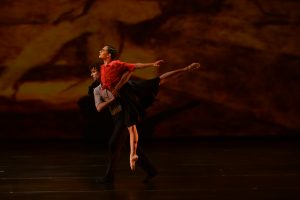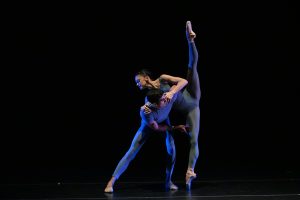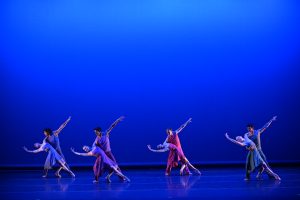
Dimensions Dance Theatre of Miami boldly took to the stage at the Duncan Theatre in Lake Worth Beach on March 21, closing out this season’s ever-popular Modern Dance Series.
Under the leadership of former Miami City Ballet Principal dancers Carlos Guerra and Jennifer Kronenberg, this small 14-member contemporary ballet company from Miami has been building acclaim for itself since its debut in 2016 and deservedly so.
For their second appearance at the Duncan, the first having been in 2023, the company presented four works from their already vast repertory of commissions and acquisitions and delivered a commanding show of action-filled choreography that highlighted the young company’s driving energy and technical savvy.
Recent times have not been easy for the performing arts. Just surviving the hardships that the pandemic imposed on the performing organizations shows that Dimensions Dance Theatre of Miami has not only staying power bur also enormous grit. In the post-performance talk-back, the dancers (many of whom are founding members of the company) showed a deep dedication and loyalty to the company.
The pearl of the evening performance was the small work nestled in the middle of the program: Surrender, choreographed by Florida choreographer Jerry Opdenaker to music by Mark O’Connor, a Grammy Award-winning American fiddle player and composer. The duet wasn’t a complicated piece, but it was just so well-formed, and together with the strong performance by resident guest artist Melissa Verdecia and Rafael Ruiz-del-Vizo, it really resonated.
We have all seen many contemporary duets about fractured relationship. They run the spectrum. Some are over-theatrical and others vague and unconvincing, but it is rare that you experience one that has just the right blend of theatricality. In Opdenaker’s duet, the couple’s fraught relationship seemed to be locked in a state of discontent that needed to play itself out for the inevitable resolution to reveal itself.
Verdecia, who was dressed in a black skirt and red top, responded to Ruiz-del-Vizo’s manhandling with flex feet and splayed hands. Layered behind the choreographed steps was a very well-timed slide show that was projected across the width of back of the stage and carefully synchronized with the theatrical peaks in the duet.
The first slides were of randomly drawn lines that evolved into a sanguine-colored drawing of a figure reclined on a couch. This series of still frames were photographed by artist Nigel Van Wieck as he worked on a painting he was constructing. Blocks of color were periodically added as the couple frustratedly tried to resolve their issues through movement and then, in one perfect and precise moment, our focus was drawn back to the drawing of the reclining figure, now painted with a black skirt and red top. It was her all along. It was as if the doomed fate of their relationship was always there — looming just behind them.

The merging of the choreography with the projected visuals was further enhanced by the color used in lighting design by Joshua Gumbinner after the original design by Lisa Gardiner. The final moment of the dance was memorable. As Verdecia lay down mirroring the painted reclining figure, Ruiz-del-Vizo (now lit as a dark silhouette) watched her with his back to audience.
The projection now added the same silhouetted form to the background. The performers and the painter’s figures were now in the same frame of time. Then in one simple and decisive gesture as Ruiz-del-Vizo and the painted figure both turned away from her, we knew that the relationship was over. That fateful moment was captured forever in the painting.
The other works on the program were larger pieces that did an excellent job of highlighting the individual talents and techniques of the company dancers. The opener, Resilience, was choreographed by Ryan Jolicoeur-Nye, who is artistic director of Oklahoma City Ballet, to music by the late Ezio Bosso, who was an award-winning Italian composer and conductor.
The cast consisted of five bare-legged women wearing pale blue leotards and pointe shoes partnered by three bare-chested men in long dark blue pants. The work had a slow and sparse beginning of both movement and music with the eight dancers grouped in duets, a trio and a solo tableau, all of which were highlighted by downward spotlights.
The mood changed with the brightening of the stage lights and both movement and music quickly accelerated until the stage space was filled with a flurry of lifts and pirouettes. Executing nice clean lines, especially in the continuous partnering, the dancers danced up a storm albeit with little facial expression. With an A-B-A format, the work returned to where it began by retrograding the various groupings till the lights faded on an opening tableau.
The group piece set in between the two intermissions was titled In Between and was created by Alysa Pires, who is an award-winning Canadian choreographer who was born and raised on the traditional territory of the W̱sáneć people near Victoria, B.C. Three couples, dressed in gray, danced to an original score by fellow Canadian composer and musical director Adam Sakiyama.
The score at the beginning of the work initially sounded like city traffic and then morphed to a more space-age kind of sound. In this ensemble dance, there was more choreographic focus on individual dancers and thus it was an opportunity to appreciate each’s individual talents.

Ruiz-del-Vizo again impressed with his easy and spacious movement quality in the first male solo, as did Ariel Morilla in his solo fluidly danced to the sparse notes of plucking guitar strings. Chloe Freytag, with her strong focus, was a commanding presence in her solo as she articulated the defined stops and holds in the choreography’s movements as was Paulina Zambrana, whose glowing presence caught my eye whenever she was onstage.
Emily Bromberg and Eric Paz were the central couple. Bromberg, who is still a principal dancer with Miami City Ballet, was as appealing and assured as ever dancing these smaller works with intimacy and her usual ease and elegance.
Imagined Notions, the lively closing ensemble piece, was a crowd-pleaser and seemed to be a favorite for the company to perform. First choreographed in 2005 by Yanis Pikieris for the now defunct Maximum Dance Company, it is set to five sections of the 1998 album Imagined Oceans by Welsh composer Karl Jenkins. Pikieris, who is artist in residence for Dimensions Dance Theatre, reworked the original choreography to custom tailor it for the company.
The curtain opened on a dark stage to reveal four women, wearing different colored camisole dresses, sitting with legs crossed on a series of black boxes of different heights. They were joined by four men who separated the seated women by wheeling the boxes around the stage, ending up with the woman wearing the same colored costume that they were wearing. Duets ensued. Each was well-danced and well-partnered and it was evident from the dancers’ now fully animated expressions how much they enjoyed dancing this work.
The same dancers danced in all the densely choreographed ensemble pieces — give or take a few, so it was hard to distinguish who was who, and who danced what in what piece, but overall, it was the strong sense of ensemble that carried the program. The women were all sparkling clean with beautiful balletic lines, the men, who had more a more contemporary dance style to their movement, were all amazing partners and all the choreography was vibrant, technical and enjoyable.
***
It is traditional at the end of the pre-curtain talk on the last show of the Duncan Theatre’s season that the executive director of theatres at Palm Beach State College announces which dance companies will be included in next year’s season. So needless to say there was much anticipation as Mary-Margaret Dale told the loyal and eager audience that the 2026 season would include Ballet X (which is known for pushing the boundaries of classical ballet and telling today’s stories with creativity and exuberance), the return of Dorrance Dance (an award-winning tap dance company based in New York City), The Sa Dance Company (an all-woman, contemporary Indian dance company from Los Angles that expresses the essence of Indian-American identity) and Gallim (the interdisciplinary dance theater company that features the works of groundbreaking choreographer Andrea Miller).
For ticket information, call the Duncan Theatre Box Office at (561) 868-3309 or visit www.duncantheatre.org.